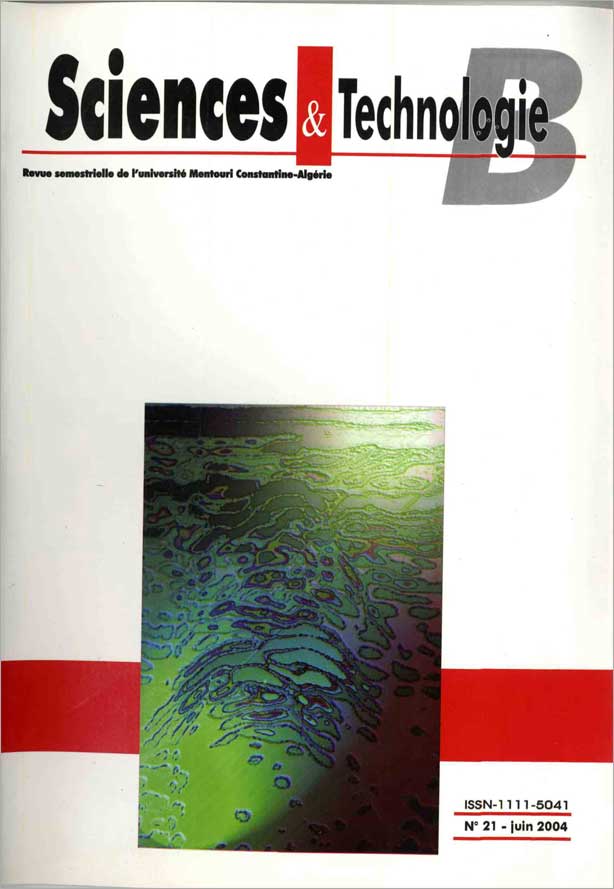RESIDUAL STRESS ANALYSIS IN SEAMLESS API X60 STEEL GAS PIPELINES
Keywords:
Residual stress, Seamless steel pipeline, Pipe slitting, Layer removalAbstract
This study is concerned with the analysis of residual strain and stress distributions through the wall of an API X60 grade high strength steel gas pipe. Residual stresses were measured using the BRSL method. This technique is based on the relaxation of stresses by splitting the tube in the longitudinal direction. Displacement measurements while notching indicated important shape changes before final split. Meanwhile, strain gages are used to monitor in real time strain behavior as a function of notch depth. It is found that relieved strains (µm/m) evolved from positive towards negative values in bored out and turned down cases. Circumferential residual stress distribution is obtained using both Mesnager-Sachs and Crampton equations. It is concluded that the latter gave realistic values as the distribution depicted compressive stresses on the outer layers and tensile stresses towards the pipe boreReferences
- Parkins R.N., Fesler R.R., "Line pipe stress corrosion cracking mechanisms and remedies", Corrosion, Paper N° 320 (1986).
- Shahinian P., Judy R.W. Jr., "Stress corrosion crack growth in surface cracked panels of high strength steels", Stress corrosion - New approaches, ASTM, STP 610 (1976), pp.128-142.
- Gray J.M., Pontremoly M., "Metallurgical options for grades X70 and X80 line pipe", International Conference on Pipe Technology, Rome, (1987), pp.171-191.
- Shi P., Mahadevan S., "Corrosion fatigue and multiple site damage reliability analysis", Int. J. Fatigue, Vol. 25 (2003), pp.457-469.
- Moulin D., Clement G., Drubay B., Goudet G., "Evaluation of ductile tearing in cracked pipes and elbows under bending", Nuclear Engineering and Design, Vol. 171 (2003), pp.33-43.
- Orynyak I.V., Torop V.M., "Modelling of the limit state of thin-walled pipes with multiple axial coplanar defects", Int. J. Pres. Ves. & Piping, Vol. 70 (1996), pp.111-115.
- Endos S. Nagae M., "Development of X100 UOE line pipe", The International Conference on Pipe Line Reliability, Calgary, 3 (1992), pp. 4.1-4.11.
- Chattopadhyay J. Dutta, B.K., Kushwaha, H.S., Mahajan S.C., Kadodkar A., "Limit load analysis and safety assessment of an elbow with a circumferential crack under a bending moment", Int. J. Pres. Ves. & Piping, Vol. 62 (1995), pp.100-116.
- Firmature R., Rahman S., "Elastic-plastic analysis of off-center cracks in cylindrical structures", Engineering Fracture Mechanics, Vol. 66 (2000), pp.15-39.
- Michel B., Plancq D., "Lower bound limit load of a circumferentially cracked pipe under combined mechanical loading", Nuclear Engineering and Design, Vol. 185 (1998), pp.23-31.
- Prevéy P.S., Cammett J.T., "The effect of shot-peening coverage on residual stress, cold work and fatigue in Ni-Cr-Mo low alloy steel", Proceedings of The International Conference on Shot-Peening, Sept. 16-20, Garmisch-Partenkirchen, Germany, (2002).
- Prevéy P. Hornbach D. Mason P. Mahoney M., "Improving corrosion fatigue performance of AA2219 friction stir welds with low plasticity burnishing", International Surface Engineering Conference, Oct. 7-10, Columbus, OH. (2002).
- Prevéy P., Hornbach D., Mason P., "Thermal residual stress relaxation and distortion in surface enhanced gas turbine engine components", Proceedings of the 17th Heat Treating Society Conference and Exposition, Eds. D.L. Milam et al., ASM, Materials Park, OH. (1998), pp.3-12.
- Ahammed M., Melchers R.E., "Reliability estimation of pressurized pipelines subject to localized corrosion defects", Int. J. Pres. Ves. & Piping, Vol. 69 (1996), pp.267-272.
- Kim Y.J, Schwalbe K.–H, Ainsworth R.A., "Simplified J-estimations based on the engineering treatment model for homogeneous and mismatched structures", Engineering Fracture Mechanics, Vol. 68 (2001), pp.9-27.
- Zerbst U., Ainsworth R.A., Schwalbe K.-H., "Basic principles of analytical flaw assessment methods", Int. J. Pres. Ves. & Piping, Vol.77 (2000), pp.855-867.
- Sachs G., "Internal stresses in metals", Zeitschrift des Vereines Deutcher Ingenieure, 71 (1927), pp.1511-1516.
- Barrett C.S., “Internal stresses-A review”, Metals and Alloys, 5 (1934), pp.131-154.
- Lynch J.J., "The measurement of residual stresses", American Society for Metals, Residual Stress Measurements, Cleveland, OH. (1952), pp. 42-96.
- Amirat A, Chaoui K., "Residual stress in seamless tubes", Synthèse, Revue des Sciences et Technologies de l’Université d’Annaba, (2001), pp.82-86.
- Sorem Jr. J.R, Shadley J.R, Rybicki E.F., "Experimental method for determining through thickness residual hoop stresses in thin walled pipes and tubes without inside access", Strain, Vol. 26 (1990), pp.7-14.
- Glinka G., "Residual stresses in fatigue and fracture: Theoretical analyses and experiments", in Residual stresses–generation, relaxation, measurement, prediction effects. A. Niku-Lari, Editor, Pergamon Press Ltd., UK (1986).
- Ueda Y., Nakacho K., Shimizu T., "Improvement of residual stresses of circumferential joint of pipe by heat-sink welding", Transactions of the ASME, 108 (1986), pp.14-23.
- ASTM STP 676, "Stress relaxation testing", Fox A., Editor, Philadelphia, PA., Committee E-28, (1979).
- Harvey J.F., "Theory and Design of Pressure Vessels", Van Nostrand Reinhold Co. Inc., New York (1985).
- Chaoui K., Amirat A., "Residual stress analysis in seamless X60 steel gas pipelines", 5ème Journées Scientifiques et Techniques, Hilton Hotel, Algiers, 16-18 December (2002).
Downloads
Published
How to Cite
Issue
Section
License
Les auteurs publiant dans cette revue acceptent les termes suivants :- Les auteurs détiennent le droit d'auteurs et accordent à la revue
le droit de première publication, avec l’ouvrage disponible simultanément [SPÉCIFIER LA PÉRIODE DE TEMPS] après publication, sous la licence Licence d’attribution Creative Commons qui permet à d'autres de partager l'ouvrage en en reconnaissant la paternité et la publication initiale dans cette revue. - Les auteurs peuvent conclure des ententes contractuelles additionnelles et séparées pour la diffusion non exclusive de la version imprimée de l'ouvrage par la revue (par ex., le dépôt institutionnel ou la publication dans un livre), accompagné d'une mention reconnaissant sa publication initiale dans cette revue.
- Les auteurs ont le droit et sont encouragés à publier leur ouvrage en ligne (par ex., dans un dépôt institutionnel ou sur le site Web d'une institution) avant et pendant le processus de soumission, car cela peut mener à des échanges fructueux ainsi qu'à un nombre plus important, plus rapidement, de références à l’ouvrage publié (Consulter The Effect of Open Access).

